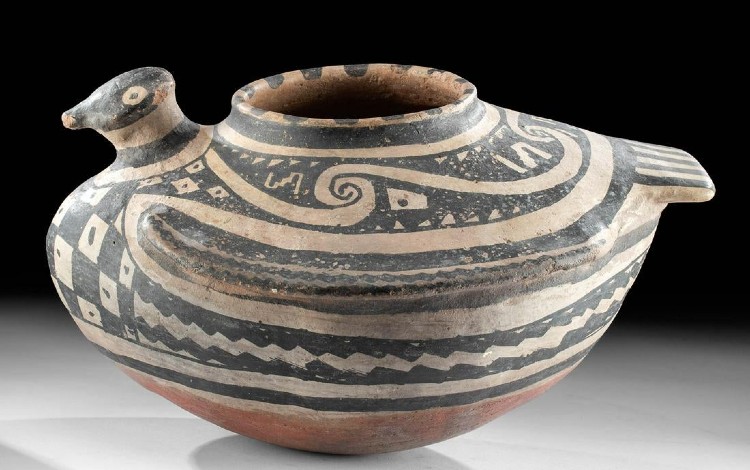
NEW YORK – Native American pottery has long been appreciated by those with an archaeologist’s interest in the past and all who simply appreciate the beautiful craftsmanship and material culture of the Southwest. For over a thousand years, indigenous people there have made pottery by hand.
While there are style differences characteristics of particular culture areas, it can be challenging for the untrained eye to distinguish between, say, a matte black Santa Clara and a San Ildefonso vase or an Acoma and Laguna olla. Groups also would trade pots with each other so it’s not surprising that the same design elements appear on pottery from different groups.
Among Pueblo peoples making pottery, traditional techniques were – and still are – passed down from generation to generation. Pottery was not thrown on a wheel but hand sculpted or coiled by hand. Groups who were nomadic had little use for pottery, which was heavy and did not travel well, but for sedentary groups with permanent settlements, it was a big part of farming and agriculture. Pottery was needed for carrying water, transporting seeds as well as ceremonial use.
Acoma
The Acoma Pueblo comprised several villages, including “Sky City,” which is perched on a mesa in New Mexico. Acoma Pueblo artists are known for their intricate cream-colored pottery painted with black and terra-cotta designs, typically using fine lines to draw geometric patterns. Anthropomorphic forms along with stylized geometric motifs are common designs.
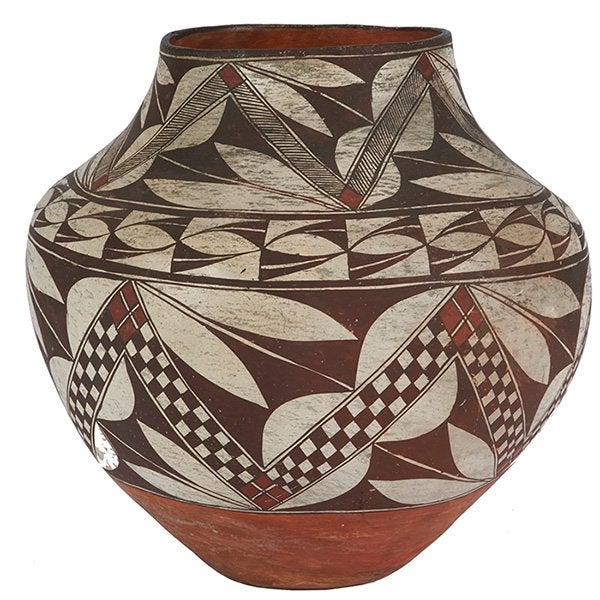
Anasazi
Anasazi pottery encompasses a wide diversity owing to how spread out its peoples were with several styles of white, gray and redware pottery seen, depending on the region. Its predominant use of these colors sets it apart from many other indigenous groups’ pottery traditions as does its “coil-and-scrape” technique. Geometric designs frequently seen include repeating series of triangles inset one another, dotted squares and wavy zigzags.
Hopi
Descended from the Anasazi and settling in Arizona, the Hopi are best known for their buff-colored or white painted pottery and usually decorated with red and black paint. Kachina decoration is rare and highly sought after but common design motifs seen include eagles and migration themes. A Hopi potter known as Nampeyo (1859–1942), put Native American pottery on the map and is thought to be the first potter to create pottery as a commercial enterprise.
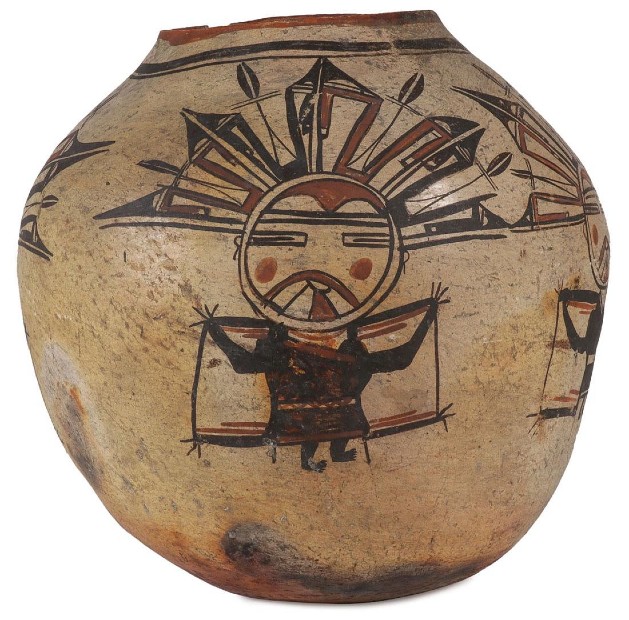
Laguna
Like Acoma pottery, with which it stylistically shares many similarities, traditional Laguna pottery is usually in the form of white pottery painted in black and terra-cotta. It can be hard to discern the two groups’ work although Laguna designs sometimes favored simpler motifs but executed in a bold style.

Navajo
Prehistoric Navajo pottery was largely utilitarian and had simple geometric decorations like random fire marks to create “fire clouds.” Because Navajo peoples were known for borrowing and adopting styles of neighboring groups, its pottery shares design similarities with other Pueblos. Some of these adopted designs include fret and maze borders. Its pottery usually is made of terra-cotta colored clay painted in bands of color, having simple etched or painted designs.
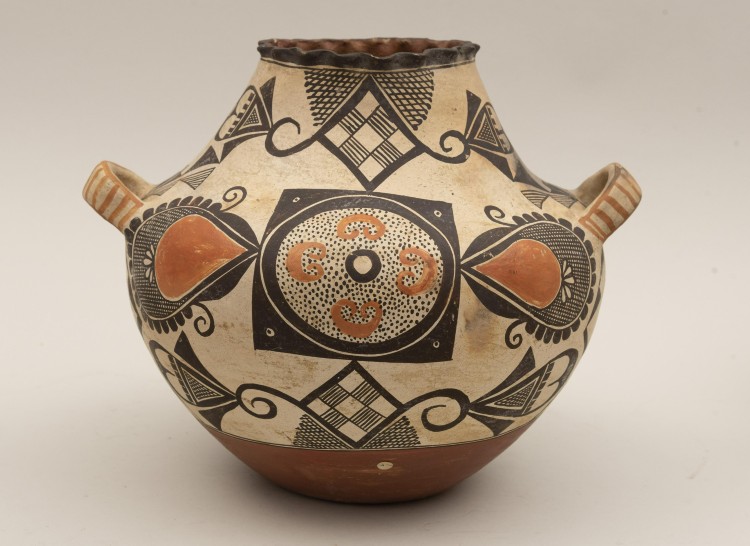
San Ildefonso
About 20 miles north of Santa Fe, N.M., the San Ildefonso Pueblo became known for its blackware pottery around 1900. Renowned by collectors for her black-on-black style, Maria Martinez remains one of its best-known potters. Common decoration elements include eagle feathers, lightning and clouds.
Santa Clara
Neighboring the San Ildefonso, Santa Clara pottery has historically shared many similarities. Its pottery is distinguished by red and black slip decoration having etched or carved designs. Pots are often made with fluted rims and oft-used designs or patterns include serpents, hummingbirds, dragonflies and floral patterns. From 1880 to 1930, pottery was noted for restrained elegance with only a red banding on the neck and shoulder and spare use of decorative elements.
Zia
Intricate designs were common to Zia pottery until 1900. After that, styles became a bit more restrained and focused on floral and geometric decoration and adding the Zia bird, Zia sun symbols or the Sky band. The pottery was usually painted with red or white slip on red enhanced with terra-cotta and black paint.
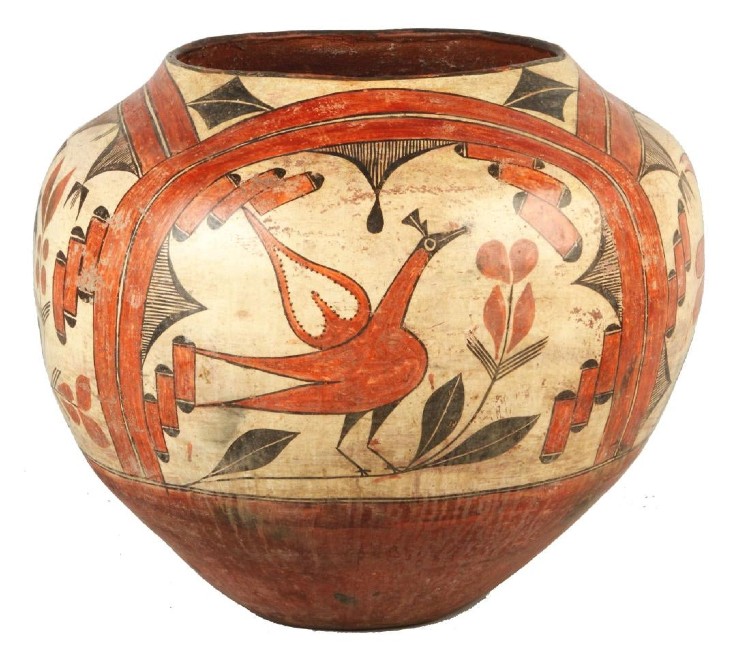
Zuni
Zuni pots typically used white or gray clay and painted them with vivid white and dark brown slips, often adding design elements painted in a dark red slip. Common designs or patterns tend to favor the geometric and abstracted and include lizards, “heart-line” deer, frogs and zigzags.
Among iconic Zuni styles dominant in the late 19th-first half 20th century are geometric abstracted rain birds and heart-line deer with rosettes.
Before deciding on a piece, study up on the category and buy from trusted sources. Taking care of a pot is crucial. The polychrome paint can be discolored by the oils on your hands, so always wash your hands before handling the pottery. Dust pieces with a soft cloth so as not to disturb the paint or its finish. Handles were made to be functional but today are best treated as decorative. Also, avoid grabbing pieces by the rims by using both hands and always support the bottom. If a vessel tips easily, place a plastic bag filled with sand inside to add stability.
Buying a Native American pot is like buying a piece of history, so choose wisely and enjoy its beauty and history.


